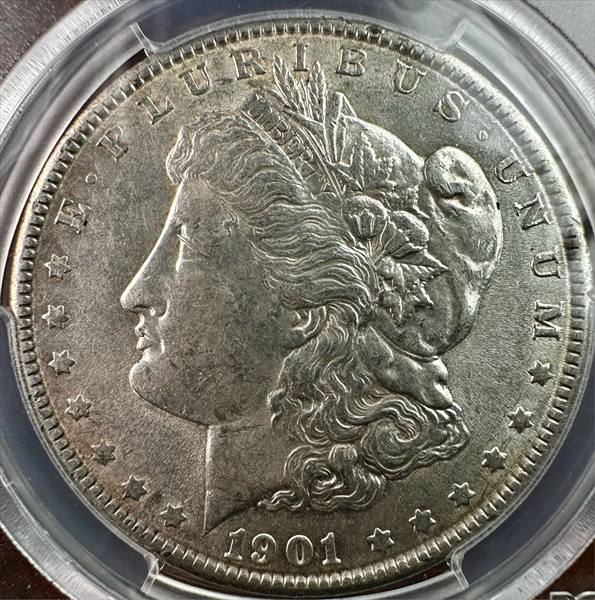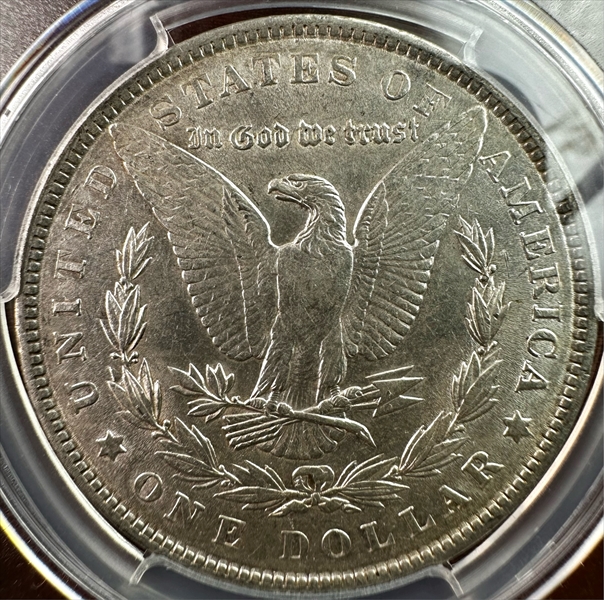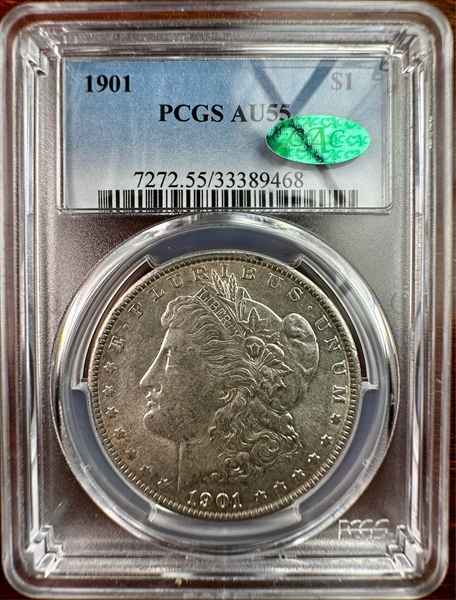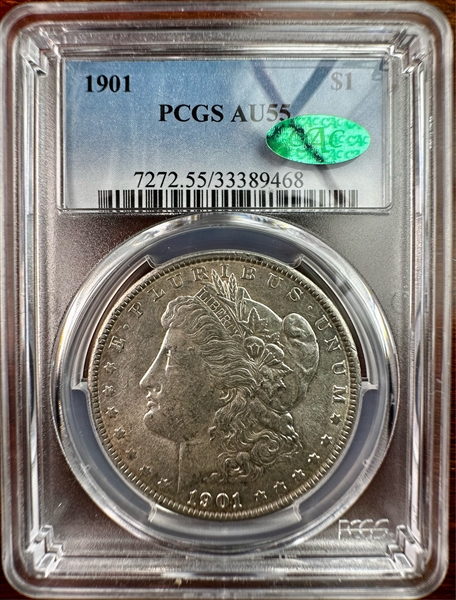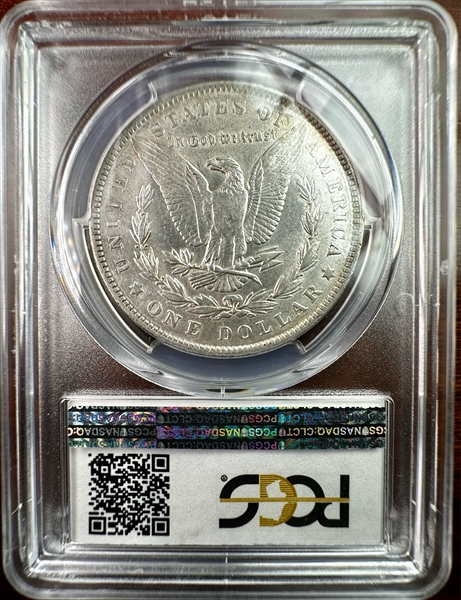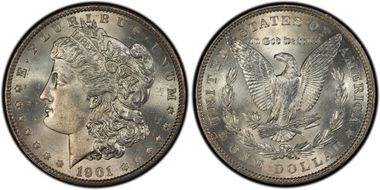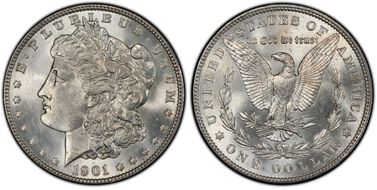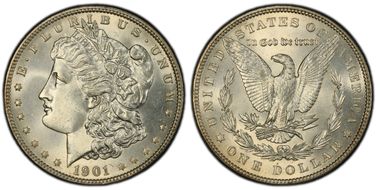1901 $1 AU55 认证号33389468, PCGS号7272
拥有者评论
CAC
专家评论
Q. David Bowers
The following narrative, with minor editing, is from my "Silver Dollars & Trade Dollars of the United States: A Complete Encyclopedia" (Wolfeboro, NH: Bowers and Merena Galleries, Inc., 1993)Numismatic Information
Commentary: Of all Philadelphia Mint circulation strike dollars, excepting the spectral 1895, the 1901 is the rarest in Mint State. Probably, many were placed into circulation at or near the time of issue. Those that were not, probably were melted under the Pittman Act of 1918.
In 1901 and for several succeeding decades, collectors desiring an example of the date ordered Proofs. Circulation strikes were neither wanted nor collected. So far as is known, this date was not represented in any Treasury releases of the 1940s, 1950s, or the remarkable early 1960s.
Over the years, very few Mint State 1901 dollars have appeared in auctions. Those that did in early sales were not recognized for their rarity; the Granberg Collection coin sold by B. Max Mehl in 1919 for $1.20 is an example. During the 1950s and 1960s, many Uncirculated 1901 dollars appeared in fixed price lists and advertisements. It is probable that most of those were what we would call AU today. However, one cannot help but wistfully wonder if such offerings as Ben Douglas' December 1951 listing at $3.95 or, better yet, Norman Shultz's January 1959 offering at only $2.50, might have been the real thing, for these men had good reputations. Be that as it may, when Morgan dollars began to be studied in detail in the 1960s, the 1901 Philadelphia Mint issue was soon recognized as a major league rarity.
Circulated grades: Circulated 1901 Morgan dollars are plentiful, but they sell for a premium due to the general unavailability of Mint State grades.
Mint State grades: While specimens remain in MS-60 to 62 grades to the extent of an estimated 750 to 1,500 pieces, at higher levels the 1901 dollar is a major rarity. Only about 100 to 200 MS-63 coins are known, just 10 to 20 in MS-64, and, possibly, only 2 to 4 in MS-65.
Most Mint State 1901 dollars are poorly struck and have inadequate lustre. A coin that is MS-60 to MS-62 from a technical viewpoint, can be dull and unattractive. As if this were not enough, most show unsightly bagmarks. As the preceding estimates show, higher grade Mint State dollars exist but are exceedingly rare. The typical specialist in silver dollars will often find that years elapse between stocking coins in as high as MS-63 grade. Forget about MS-64 and MS-65.
As noted, many coins sold as "Uncirculated" over the years are what we would call AU today. My advice is to buy no 1901 dollar that is not certified.
Prooflike coins: The 1901 is exceedingly rare with PL or DMPL finish. Only two DMPLs were known to Wayne Miller when he wrote his book in 1982, and few if any have turned up on the market since. One mentioned by Miller was in a Spokane, Washington collection in 1980, and the second was sold with the Bruce Todd Collection in January 1973.
Caveat emptor: Fake 1901 "Philadelphia" coins are sometimes made by removing the 0 or S mintmark from a branch mint coin.
Varieties
OLD REVERSE HUB: NARROW WING/NECK SPACE, SMALL STARS VAM C-3
Circulation strikes:
1. VAM-1. Usually seen in AU or slider grade. Walter H. Breen has seen no old hub coins in full Mint State, prooflike, DMPL, or Proof. Probably not all the 43 obverses and 44 reverses were used; these figures include reverses from the new hub (below).
NEW OVER OLD HUB: DOUBLE OLIVE AT CLAW
VAM C-4 OVER C-3 REVERSE
Circulation strikes:
1. C-4 reverse hub over C-3: Breen-5681, VAM-5, 6, 7, 9. Most 1901 dollars have not been inspected for this feature. Slightly scarce.
NEW REVERSE HUB: WIDE NECK/WING SPACE, LARGE STARS VAMC-4
Circulation strikes:
1. Breen-5679, VAM-2. Sliders are common and sometimes were graded MS-60 to 63 before the advent of PCGS and NGC. Prooflikes exist from this reverse (of the two reported by Wayne Miller).
2. Doubled die reverse, "Shifted Eagle": Breen-5680, VAM-3, F&S $1-010. Doubling plainest at eagle; 14 tail feathers. Rare. One Mint State coin (ANACS MS-61) is known in a population estimated to be just a few dozen pieces in all grades. The unpublicized VAM-7 is another reverse doubled die.
Dies prepared: Obverse: 43; Reverse: 44
Circulation strike mintage: 6,962,000; Delivery figures by month: January: 360,000; February: 500,000; March: 42,000; April: none; May: 824,000; June: 1,462,000; July: 400,000; August: 1,514,000; September: 1,740,000; October: 86,000; November: none; December: 34,000.
Estimated quantity melted: Possibly about 5,000,000 under the 1918 Pittman Act.
Availability of prooflike coins: Writing in 1982, Wayne Miller knew of only two DMPL specimens.
Characteristics of striking: Usually poorly struck.
Known hoards of Mint State coins: None.
Distribution of Dollars
The Annual Report of the Director of the Mint, 1901, told of distribution of dollars during the fiscal year: Philadelphia: In the mint July 1,1900,73,243,954; transferred from Treasury for storage, 5,000,000; coinage, fiscal year 1901, 8,500,850; total, 86,744,804; in mint July 1, 1901 86,075,954; total, 86,075,954; distributed from mint, 668,850.
PCGS #
7272
设计师
George T. Morgan
边缘
Reeded
直径
38.10 毫米
重量
26.73 克
铸币数量
6962000
金属成分
90% Silver, 10% Copper
更高评级数量
2339
评级较低的钱币数量
3428
地区
The United States of America
价格指南
PCGS 数量报告
拍卖 - PCGS 评级的
拍卖 - NGC 评级的
稀有性和存量估计 了解更多
| 所有评级 | 696900 |
| 60或以上 | 10000 |
| 65或以上 | 8 |
| 所有评级 | R-1.4 |
| 60或以上 | R-3.0 |
| 65或以上 | R-9.6 |
| 所有评级 | 76 / 117 TIE |
| 60或以上 | 24 / 117 TIE |
| 65或以上 | 4 / 117 TIE |
| 所有评级 | 76 / 117 TIE |
| 60或以上 | 24 / 117 TIE |
| 65或以上 | 4 / 117 TIE |




















